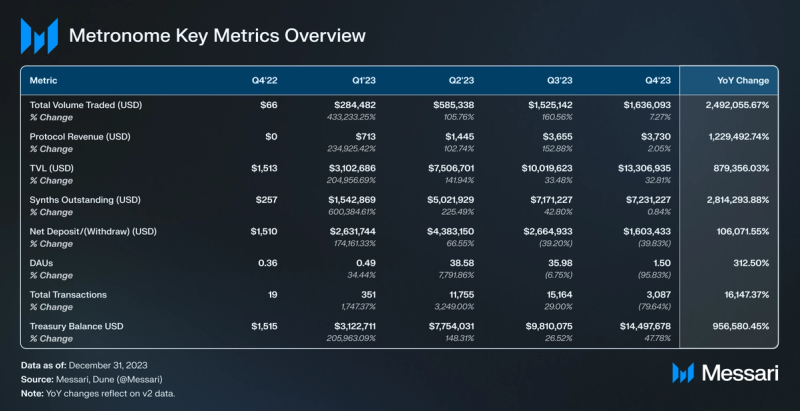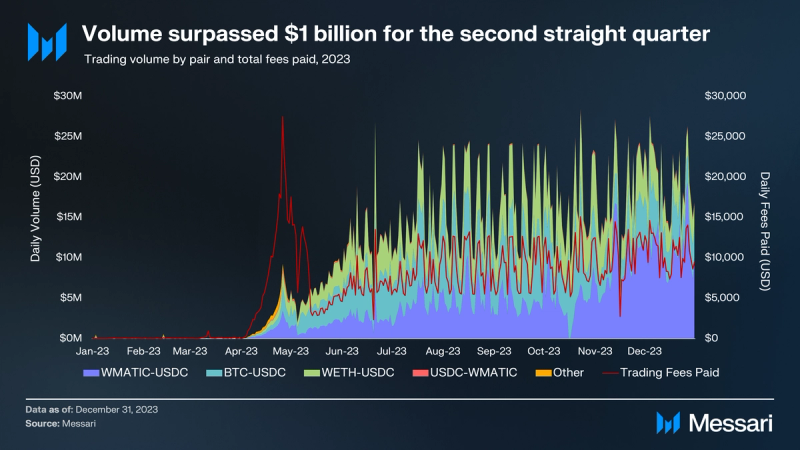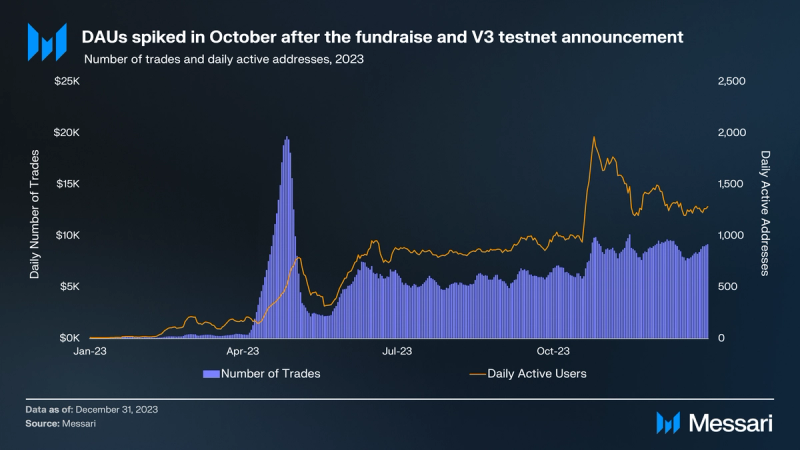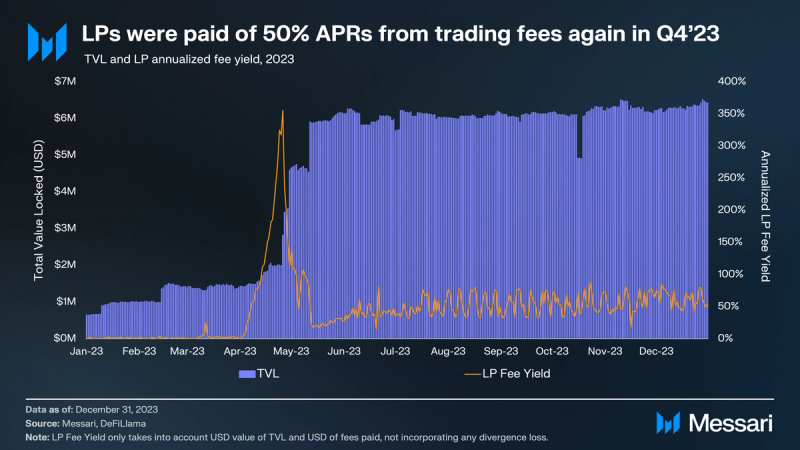Key Insights
- SynFutures V3 testnet and alpha launched, enabling users to trade with up to 100x leverage. It also helps protect LPs and limit order makers through a dynamic penalty fee framework. The mainnet is expected to launch in Q1’24.
- SynFutures added Blast testnet to its roadmap, aiming to use the native yield design to build unique user experiences around zero-fee trading.
- V2 usage brought in $1.66 billion in volume and nearly $1 million in fees paid in Q4’23.
- Activity increased throughout the quarter, with record volumes, fees, and daily active users. SynFutures V2 also drew nearly 12,000 new addresses that transacted on the protocol during Q4’23.
Primer on SynFutures V2
SynFutures is a decentralized derivatives exchange deployed on Polygon Mainnet and zkSync Era. Though the platform has yet to launch a native token, the SynFutures team is considering it and recently secured $22 million in a Series B funding round spearheaded by Pantera Capital. Through a single-token liquidity model, SynFutures enables users to freely list and trade any asset in seconds, without centralized intervention or DAO proposals. The spot price for each underlying asset derives from oracles such as Chainlink or spot DEX markets and uses an exponential moving average to smooth volatility. The synthetic automated market maker (sAMM) model of SynFutures V1 facilitated over $18 billion in trading volume, serving more than 50,000 traders across 257 underlyings.
To enhance the trading experience, V2 was publicly released in May 2023, focusing on perpetual futures. This move enabled SynFutures to offer a better UX experience by eliminating the need for users to roll over positions and juggle separate margins. Additionally, V2 introduced unique mechanics to guarantee the futures price convergence to the spot price. Unlike other perpetual futures contracts that have traders pay the funding rate out of their margin account on a fixed schedule, the funding rate on SynFutures is reflected in a trader’s PnL and is determined by the price discrepancy between the spot price and perpetual futures contract price every day at 8 a.m. UTC.
Website / X (Twitter) / Discord
V2 Key Metrics

Introducing SynFutures V3
Just six months after the public release of V2, the team unveiled SynFutures V3: The Oyster AMM Model for Next-Gen DeFi Derivatives. This evolution of the protocol’s AMM aims to provide a capital efficiency that rivals centralized alternatives without sacrificing transparency. The AMM’s unique design houses range-bound liquidity with the additional functionality of a traditional order book. To enable native limit orders like those in central limited order book systems, it ditches the first-in/first-out approach for a matching process better suited for AMMs.

Source: SynFutures
Each liquidity provision within the Oyster AMM is treated as a self-contained AMM, concentrated around the prevailing price of the underlying. Liquidity providers (LPs) only need to specify the width of their desired range. Native limit orders are defined at single price points and irreversible once filled. This design allows for atomic transactions and provides makers with certainty of the status of their limit orders.
The AMM uses a smart contract struct termed “Pearl” to encapsulate the collection of concentrated liquidity positions at a specific price point, as well as all open limit orders at that price. The Oyster AMM resembles a pearl necklace, with each Pearl representing a point along the AMM price curve. At any given price point with existing limit orders, limit orders are prioritized and filled before tapping into any concentrated liquidity. Thus, if a taker’s trade size stays within the existing limit orders at a specific price, it can avoid slippage, allowing the Oyster AMM to compete with the efficiency of centralized exchanges.
Compared to V2, the Oyster AMM has lower margin requirements, allowing users to trade with up to 100x leverage. To protect LPs and makers, the lower margin requirement is balanced by a dynamic penalty fee framework. It works by increasing the fees paid to liquidity providers if a trade results in significant deviations between the fair price and mark price.
For more on SynFutures V3, please see Messari’s Q3 report.
V2 Performance Analysis

Trading volume rose again on SynFutures, as market activity and prices climbed. In Q3’23, the BTC-USDC pair volume was $622 million, making up 42% of the total for the quarter. In the fourth quarter, the WMATIC-USDC pair became the most traded pair with 46% of activity, or $765 million in volume in the quarter. The top three pairs (WMATIC, BTC, and ETH) accounted for 99% of SynFutures volume for the second consecutive quarter.
Higher volumes drove higher fees, and SynFutures LPs enjoyed the highest fee intake since inception of over $900,000 in Q4. Currently, the protocol charges a static 0.03% trading fee if trades move the price by less than 10%. For trades that move the market by 10% or more, there is a larger fee of 1.2%. Participating as an LP on V2 is currently gated as the team transitions users off of V2. These actions limit new TVL and likely keep fee yield at above-market rates.

Activity on SynFuture V2 increased in the fourth quarter. The number of trades executed rose nearly 50% to 765,000, and the protocol attracted another 12,000 new addresses. While DAUs were steadily increasing, there was a spike in DAUs after the October announcements that it closed a new funding round and launched the V3 testnet. The higher usage numbers persisted for the rest of the quarter. It is likely that the combination of these announcements drove usage and increased speculation of an airdrop, given there is no liquid token yet.

Providing liquidity on SynFutures as an LP is currently a permissioned process as the team winds down V2 usage and focuses efforts on launching V3 in Q1. As such, TVL stayed flat above $6 million, despite the high yields from fees. The remaining LPs are reaping the benefits of the increased usage, earning over 50% annualized yield on their deposits for the third consecutive quarter.
Qualitative Analysis
V3 Testnet Launch
On October 19, SynFutures made two big announcements. SynFutures announced that it successfully raised $22 million in a Series B funding round. This round was led by Pantera Capital, with significant contributions from SIG DT Investments and HashKey Capital. The influx of capital is earmarked for product development and the expansion of the project across multiple blockchains.
The launch of SynFutures V3 testnet was the other crucial development. This new platform iteration includes the Oyster automated market maker (AMM), which stands out for its unique blend of order book and AMM models. The Oyster AMM is designed to enhance trading efficiency by concentrating liquidity, a feature that sets it apart from other platforms. It achieves this by allowing LPs to offer deeper liquidity with the same value of assets, facilitating higher yields for liquidity providers. The testnet launch has seen strong adoption and promising proof of concept for the new product.
Expanding to Blast
SynFutures has recently made a significant move by launching a testnet on Blast, a new Ethereum Layer-2 solution. This strategic development holds significant potential implications for the protocol and its users, as Blast’s unique economics for yielding assets could create a new and unique experience for perp traders.
Blast, as a Layer-2 protocol, offers native yield on assets like ETH and stablecoins. This feature aligns with the needs of traders seeking to maximize their asset yield while engaging in various DeFi activities, such as trading on SynFutures V3.
The integration with Blast is expected to enhance the trading experience on SynFutures by potentially offering zero trading fees. It will also use collateral and margin in innovative ways, such as returning yield to the users or subsidizing gas fees. This approach is different from the typical airdrop or token launch strategies, focusing instead on practical benefits that improve the trading experience. As of writing, no perp DEX has ever sustainably incentivized its users to hold assets on the exchange, which SynFutures is seeking to change with Blast.
The introduction of Blast in SynFutures’ ecosystem also helps to address some critical challenges faced by users, especially those related to high gas costs on Ethereum Mainnet. SynFutures had experimented with incorporating liquid staking token (LST) assets as liquidity provision (LP) / margin tokens through its DAO Perps program. However, Ethereum’s high gas costs rendered many trading strategies unprofitable, even after accounting for LST yield. Blast’s Layer-2 environment, with its lower gas costs, presents a more viable platform for executing such strategies efficiently.
In summary, SynFutures’ launch on Blast’s Layer-2 promises to enhance the platform’s efficiency and user experience, particularly in terms of innovative use cases for trading fees and collateral.
Closing Summary
SynFutures V2 continues to compete in the perp DEX market, executing over $1.6 billion in volume in Q4 and nearly $1 million in fees paid. Q4’23 also brought big announcements from the team around completing a Series B fundraiser, launching the V3 testnet, and adding a deployment on Blast to its roadmap. The first quarter of 2024 carries much anticipation with the expected launches of SynFutures V3 and the new Oyster AMM.


















